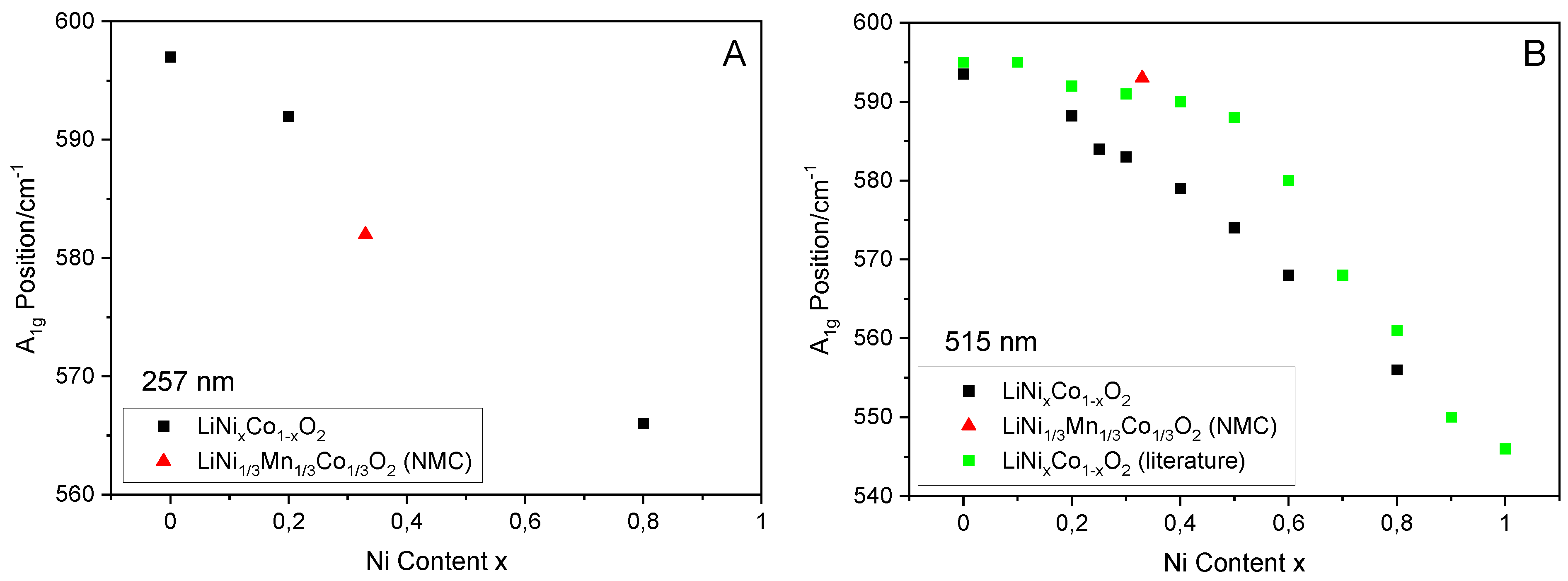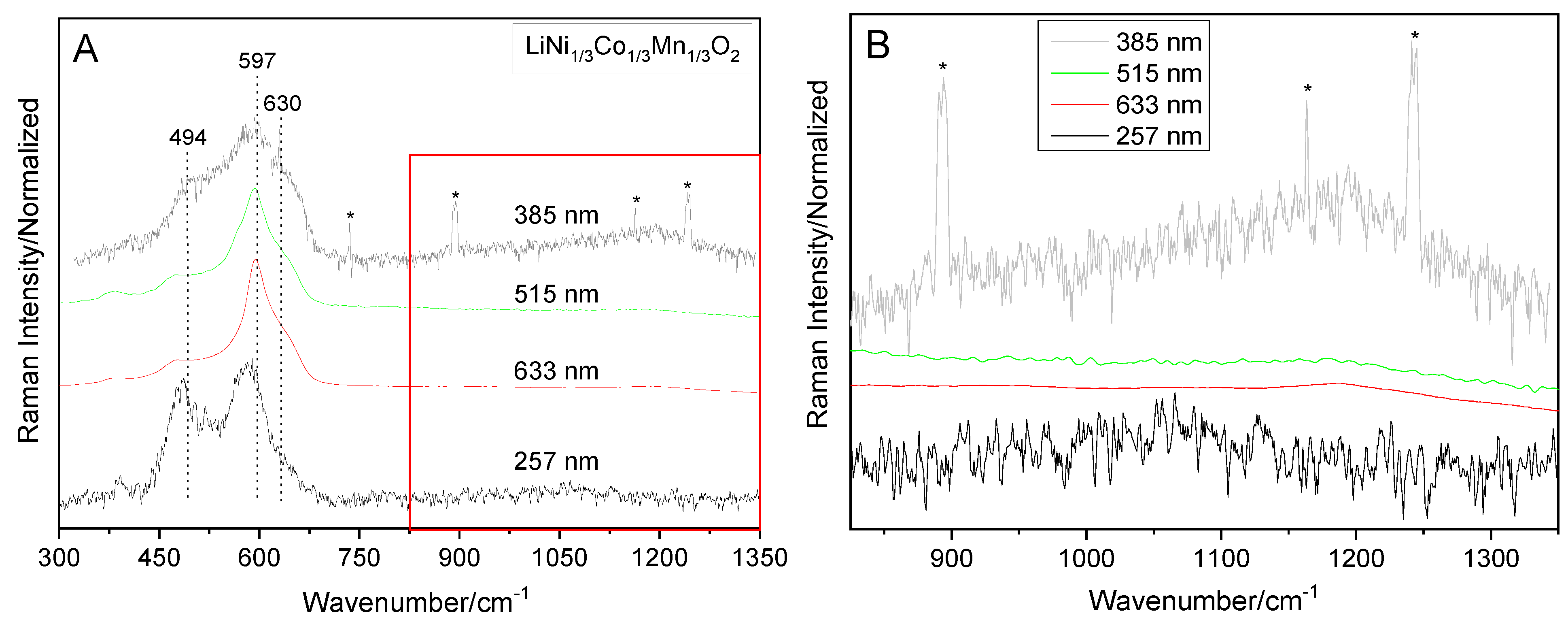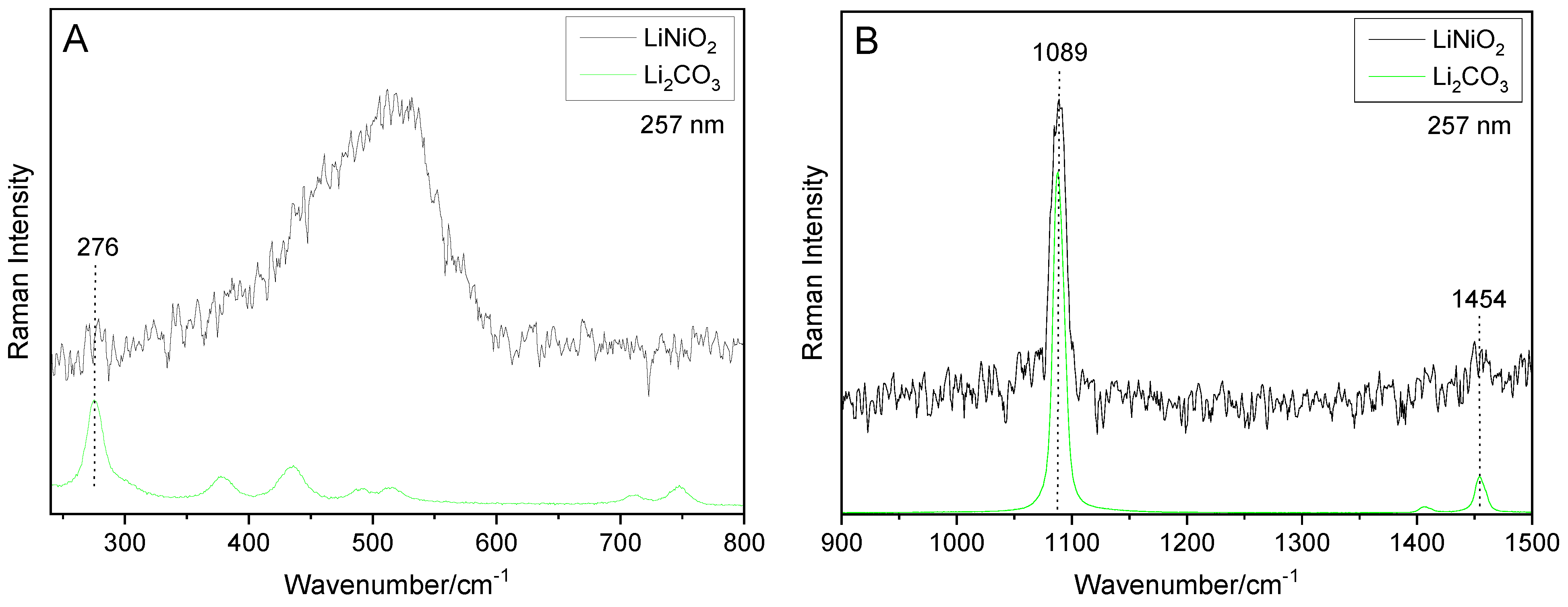Raman Diagnostics of Cathode Materials for Li-Ion Batteries Using Multi-Wavelength Excitation
Abstract
:1. Introduction
2. Experimental Section
2.1. Preparation of Cathode Materials
2.2. Characterization
3. Results and Discussion
3.1. LiCoO2
3.2. LiNiyCo1−yO2
3.3. LiNi1/3Mn1/3Co1/3O2 (NMC)
3.4. Detection of Surface and Precursor Species
4. Conclusions
Supplementary Materials
Author Contributions
Funding
Institutional Review Board Statement
Informed Consent Statement
Data Availability Statement
Acknowledgments
Conflicts of Interest
References
- Etacheri, V.; Marom, R.; Elazari, R.; Salitra, G.; Aurbach, D. Challenges in the development of advanced Li-ion batteries: A review. Energy Environ. Sci. 2011, 4, 3243–3262. [Google Scholar] [CrossRef]
- Nitta, N.; Wu, F.; Lee, J.T.; Yushin, G. Li-ion battery materials: Present and future. Mater. Today 2015, 18, 252–264. [Google Scholar] [CrossRef]
- Manthiram, A. A reflection on lithium-ion battery cathode chemistry. Nat. Commun. 2020, 11, 1550. [Google Scholar] [CrossRef] [PubMed]
- Liu, H.S.; Zhang, Z.R.; Gong, Z.L.; Yang, Y. Origin of deterioration for LiNiO2 cathode material during storage in air. Electrochem. Solid-State Lett. 2004, 7, A190–A193. [Google Scholar] [CrossRef]
- Yabuuchi, N.; Ohzuku, T. Novel lithium insertion material of LiCo1/3Ni1/3Mn1/3O2 for advanced lithium-ion batteries. Power Sources 2003, 171, 119–121. [Google Scholar] [CrossRef]
- Liu, W.; Oh, P.; Liu, X.; Lee, M.J.; Cho, W.; Chae, S.; Kim, Y.; Cho, J. Nickel-rich layered lithium transition-metal oxide for high-energy lithium-ion batteries. Angew. Chem. Int. Ed. 2015, 54, 4440–4457. [Google Scholar] [CrossRef]
- Guo, B.; Zhao, J.H.; Fan, X.M.; Zhang, W.; Li, S.; Yang, Z.H.; Chen, Z.X.; Zhang, W.X. Aluminum and fluorine co-doping for promotion of stability and safety of lithium-rich layered cathode material. Electrochim. Acta 2017, 236, 171–179. [Google Scholar] [CrossRef]
- Hausbrand, R.; Cherkashinin, G.; Ehrenberg, H.; Gröting, M.; Albe, K.; Hess, C.; Jaegermann, W. Fundamental degradation mechanisms of layered oxide Li-ion battery cathode materials: Methodology, insights and novel approaches. Mater. Sci. Eng. B. 2015, 192, 3–25. [Google Scholar] [CrossRef]
- Pender, J.P.; Jha, G.; Youn, D.H.; Ziegler, J.M.; Andoni, I.; Choi, E.J.; Heller, A.; Dunn, B.S.; Weiss, P.S.; Penner, R.M.; et al. Electrode degradation in lithium-ion batteries. ACS Nano 2020, 14, 1243–1295. [Google Scholar] [CrossRef] [Green Version]
- Baddour-Hadjean, R.; Pereira-Ramos, J.P. Raman microspectrometry applied to the study of electrode materials for lithium batteries. Chem. Rev. 2010, 110, 1278–1319. [Google Scholar] [CrossRef]
- Tripathi, A.M.; Su, W.N.; Hwang, B.J. In situ analytical techniques for battery interface analysis. Chem. Soc. Rev. 2018, 47, 736–851. [Google Scholar] [CrossRef] [PubMed]
- Flores, E.; Novák, P.; Berg, E.J. In situ and operando Raman spectroscopy of layered transition metal oxides for Li-ion battery cathodes. Front. Energy Res. 2018, 6, 82. [Google Scholar] [CrossRef]
- Julien, C.M.; Mauger, A. In situ Raman analyses of electrode materials for Li-ion batteries. AIMS Mater. Sci. 2018, 5, 650. [Google Scholar] [CrossRef]
- Flores, E.; Novák, P.; Aschauer, U.; Berg, E.J. Cation Ordering and Redox Chemistry of Layered Ni-Rich LixNi1–2yCoyMnyO2: An Operando Raman Spectroscopy Study. Chem. Mater. 2020, 32, 186–194. [Google Scholar] [CrossRef]
- Jehnichen, P.; Korte, C. Operando Raman Spectroscopy Measurements of a High-Voltage Cathode Material for Lithium-Ion Batteries. Anal. Chem. 2019, 91, 8054–8061. [Google Scholar] [CrossRef]
- Matsuda, Y.; Kuwata, N.; Okawa, T.; Dorai, A.; Kamishima, O.; Kawamura, J. In situ Raman spectroscopy of LixCoO2 cathode in Li/Li3PO4/LiCoO2 all-solid-state thin-film lithium battery. Solid State Ionics 2019, 335, 7–14. [Google Scholar] [CrossRef]
- Otoyama, M.; Ito, Y.; Sakuda, A.; Tatsumisago, M.; Hayashi, A. Reaction uniformity visualized by Raman imaging in the composite electrode layers of all-solid-state lithium batteries. Phys. Chem. Chem. Phys. 2020, 22, 13271–13276. [Google Scholar] [CrossRef]
- Flores, E.; Mozhzhukhina, N.; Aschauer, U.; Berg, E.J. Operando Monitoring the Insulator–Metal Transition of LiCoO2. ACS Appl. Mater. Interfaces 2021, 13, 22540–22548. [Google Scholar] [CrossRef]
- Yellampalle, B.; Sluch, M.; Asher, S.; Lemoff, B. Multiple-excitation-wavelength resonance-Raman explosives detection. Proc. SPIE 2011, 8018, 801819. [Google Scholar]
- Gross, T.; Hess, C. Raman diagnostics of LiCoO2 electrodes for lithium-ion batteries. J. Power Sources 2014, 256, 220–225. [Google Scholar] [CrossRef]
- Julien, C.M.; Massot, M.; Ramana, C.V. Structure of electrode materials for Li-ion batteries: The Raman spectroscopy investigations. In Portable and Emergency Energy Sources; Stoynov, Z., Vladikova, D., Eds.; Martin Drinov Academic Publishing House: Sofia, Bulgaria, 2006. [Google Scholar]
- Ammundsen, B.; Burns, G.R.; Islam, M.S.; Kanoh, H.; Rozière, J. Lattice dynamics and vibrational spectra of lithium manganese oxides: A computer simulation and spectroscopic study. J. Phys. Chem. B 1999, 103, 5175–5180. [Google Scholar] [CrossRef]
- Lei, J.; McLarnon, F.; Kostecki, R. In situ raman microscopy of individual LiNi0.8Co0.15Al0.05O2 particles in a Li-ion battery composite cathode. J. Phys. Chem. B 2005, 109, 952–957. [Google Scholar] [CrossRef] [PubMed] [Green Version]
- Dokko, K.; Mohamedi, M.; Anzue, N.; Itoh, T.; Uchida, I. In situ Raman spectroscopic studies of LiNixMn2−xO4 thin film cathode materials for lithium ion secondary batteries. J. Mater. Chem. 2002, 12, 3688–3693. [Google Scholar] [CrossRef]
- Kerlau, M.; Marcinek, M.; Srinivasan, V.; Kostecki, R.M. Studies of local degradation phenomena in composite cathodes for lithium-ion batteries. Electrochim. Acta 2007, 53, 1385–1392. [Google Scholar] [CrossRef]
- Pechini, P.M. Method of Preparing Lead and Alkaline Earth Titanates and Niobates and Coating Method Using the Same to form a Capacitor. U.S. Patent Nr. 3.330.697, 11 July 1967. [Google Scholar]
- Toby, B.H.; Von Dreele, R.B. GSAS-II: The genesis of a modern open-source all purpose crystallography software package. J. Appl. Cryst. 2013, 46, 544–549. [Google Scholar] [CrossRef]
- Inaba, M.; Iriyama, Y.; Ogumi, Z.; Todzuka, Y.; Tasaka, A. Raman study of layered rock-salt LiCoO2 and its electrochemical lithium deintercalation. J. Raman Spectrosc. 1997, 28, 613–617. [Google Scholar] [CrossRef]
- Ghosh, P.; Mahanty, S.; Raja, M.W.; Basu, R.N.; Maiti, H.S. Structure and optical absorption of combustion-synthesized nanocrystalline LiCoO2. J. Mater. Res. 2006, 22, 1162–1167. [Google Scholar] [CrossRef] [Green Version]
- Rao, K.J.; Benqlilou-Moudden, H.; Desbat, B.; Vinatier, P.; Levasseur, A. Infrared spectroscopic study of LiCoO2 thin films. J. Solid State Chem. 2002, 165, 42–47. [Google Scholar] [CrossRef]
- Julien, C. Local cationic environment in lithium nickel–cobalt oxides used as cathode materials for lithium batteries. Solid State Ionics 2000, 136–137, 887–896. [Google Scholar] [CrossRef]
- Inaba, M.; Todzuka, Y.; Yoshida, H.; Grincourt, Y.; Tasaka, A.; Tomida, Y.; Ogumi, Z. Raman spectra of LiCo1-yNiyO2. Chem. Lett. 1995, 24, 889–890. [Google Scholar] [CrossRef]
- Kalyani, P.; Kalaiselvi, N. Various aspects of LiNiO2 chemistry: A review. Sci. Technol. Adv. Mater. 2005, 6, 689–703. [Google Scholar] [CrossRef] [Green Version]
- Chakraborty, A.; Dixit, M.; Aurbach, D.; Major, D.T. Predicting accurate cathode properties of layered oxide materials using the SCAN meta-GGA density functional. NPJ Comput. Mater. 2018, 4, 60. [Google Scholar] [CrossRef]
- Laubach, S.; Laubach, S.; Schmidt, P.C.; Ensling, D.; Schmid, S.; Jaegermann, W.; Thißen, A.; Nikolowski, K.; Ehrenberg, H. Changes in the crystal and electronic structure of LiCoO2 and LiNiO2 upon Li intercalation and de-intercalation. Phys. Chem. Chem. Phys. 2009, 11, 3278–3289. [Google Scholar] [CrossRef] [PubMed]
- Dahn, J.R.; von Sacken, U.; Michal, C.A. Structure and electrochemistry of Li1±yNiO2 and a new Li2NiO2 phase with the Ni(OH)2 structure. Solid State Ionics 1990, 44, 87–97. [Google Scholar] [CrossRef]
- Zhang, X.; Mauger, A.; Lu, Q.; Groult, H.; Perrigaud, L.; Gendron, F.; Julien, C.M. Synthesis and characterization of LiNi1/3Mn1/3Co1/3O2 by wet-chemical method. Electrochim. Acta 2010, 55, 6440–6449. [Google Scholar] [CrossRef]
- Ruther, R.E.; Callender, A.F.; Zhou, H.; Martha, S.K.; Nanda, J. Raman microscopy of lithium-manganese-rich transition metal oxide cathodes. Electrochem. Soc. 2015, 162, A98. [Google Scholar] [CrossRef] [Green Version]
- Ghanty, C.; Markovsky, B.; Erickson, E.M.; Talianker, M.; Haik, O.; Tal-Yossef, Y.; Mor, A.; Aurbach, D.; Lampert, J.; Volkov, A.; et al. Li+-ion extraction/insertion of Ni-rich Li1+ x(NiyCozMnz)wO2 (0.005 < x < 0.03; y:z = 8:1, w ≈ 1) electrodes: In situ XRD and Raman spectroscopy study. ChemElectroChem 2015, 2, 1479–1486. [Google Scholar]
- Julien, C.M.; Massot, M. Raman scattering of LiNi1−yAlyO2. Solid State Ionics 2002, 148, 53–59. [Google Scholar] [CrossRef]
- Brooker, M.H.; Bates, J.B. Raman and infrared spectral studies of anhydrous Li2CO3 and Na2CO3. J. Chem. Phys. 1971, 54, 4788–4796. [Google Scholar] [CrossRef]
- Koura, N.; Kohara, S.; Takeuchi, K.; Takahashi, S.; Curtiss, L.A. Alkali carbonates: Raman spectroscopy, ab initio calculations, and structure. J. Mol. Struct. 1996, 382, 163–169. [Google Scholar] [CrossRef]
- Brooker, M.H.; Wang, J. Raman and infrared studies of lithium and cesium carbonates. Spectrochim. Acta 1992, 48A, 999–1008. [Google Scholar] [CrossRef]
- James, D.W.; Leong, W.H. Structure of molten nitrates. III. Vibrational spectra of LiNO3, NaNO3, and AgNO3. J. Chem. Phys. 1969, 51, 640–646. [Google Scholar] [CrossRef] [Green Version]
- Gross, T.; Buhrmester, T.; Bramnik, K.G.; Bramnik, N.N.; Nikolowski, K.; Baehtz, C.; Ehrenberg, H.; Fuess, H. Structure–intercalation relationships in LiNiyCo1-yO2. Solid State Ionics 2005, 176, 1193–1199. [Google Scholar] [CrossRef]





| Fundamental (cm−1) | Overtone/Combination (cm−1) | Assignment |
|---|---|---|
| 486 | Eg | |
| 980 | 2Eg | |
| 1070 | 2Eu, A1g × Eg | |
| 595 | A1g | |
| 1155, 1167 | A2u × Eu, 2A1g, 2A2u | |
| 1242 | 2A2u | |
| 1320 | 2A2u |
Publisher’s Note: MDPI stays neutral with regard to jurisdictional claims in published maps and institutional affiliations. |
© 2022 by the authors. Licensee MDPI, Basel, Switzerland. This article is an open access article distributed under the terms and conditions of the Creative Commons Attribution (CC BY) license (https://creativecommons.org/licenses/by/4.0/).
Share and Cite
Heber, M.; Hofmann, K.; Hess, C. Raman Diagnostics of Cathode Materials for Li-Ion Batteries Using Multi-Wavelength Excitation. Batteries 2022, 8, 10. https://doi.org/10.3390/batteries8020010
Heber M, Hofmann K, Hess C. Raman Diagnostics of Cathode Materials for Li-Ion Batteries Using Multi-Wavelength Excitation. Batteries. 2022; 8(2):10. https://doi.org/10.3390/batteries8020010
Chicago/Turabian StyleHeber, Marcel, Kathrin Hofmann, and Christian Hess. 2022. "Raman Diagnostics of Cathode Materials for Li-Ion Batteries Using Multi-Wavelength Excitation" Batteries 8, no. 2: 10. https://doi.org/10.3390/batteries8020010






